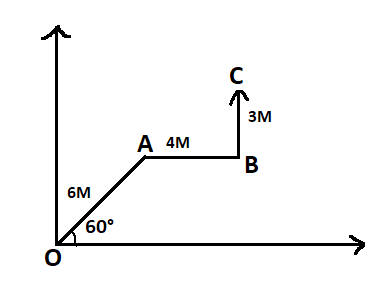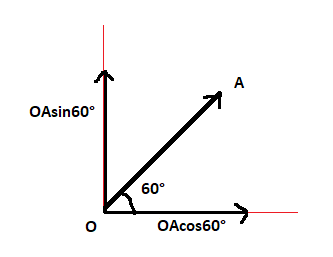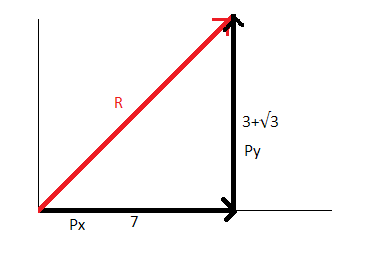
Resultant by component method:

Answer
217.8k+ views
Hint: Split the vectors along X and Y axis respectively. Then add all the vectors along X-axis and all the vectors along Y-axis. Use the formula to find the resultant vectors.
Complete step by step solution:
Since the \[\overline{OA}\] is not parallel to any axes hence we will need to take components of the \[\overline{OA}\] along X-axis and Y-axis. The vectors AB and BC are parallel to X-axis and Y-axis respectively. We need to find the component of \[\overline{OA}\] in the X and Y direction.

From the above both figures we can have the vectors in both X-axis and Y-axis, since the component of \[\overline{OA}\] is now in both axes.
\[|{\overrightarrow {OA} _x}| = |OA|\cos {60^ \circ } = 6(\frac{1}{2}) = 3\]
\[|{\overrightarrow {AB} _x}| = |AB|\cos \theta = 4\cos {0^ \circ } = 4(1) = 4\]
\[|{\overrightarrow {OA} _y}| = |OA|\sin {60^ \circ } = 6(\frac{{\sqrt 3 }}{2}) = 3\sqrt 3 \]\[|{\overrightarrow {OA} _y}| = |OA|\sin {60^ \circ } = 6(\frac{{\sqrt 3 }}{2}) = 3\sqrt 3 \]
\[|{\overrightarrow {BC} _y}| = |BC|\sin \theta = 3\sin {90^ \circ } = 3(1) = 3\]
Adding all the three vectors along X and Y direction we get
\[\overrightarrow{{{P}_{x}}}=\overrightarrow{O{{A}_{x}}}+\overrightarrow{A{{B}_{x}}}+\overrightarrow{B{{C}_{x}}}\] \[\overrightarrow{{{P}_{y}}}=\overrightarrow{O{{A}_{y}}}+\overrightarrow{A{{B}_{y}}}+\overrightarrow{B{{C}_{y}}}\]
Since we have already calculated the magnitudes of all three vectors, we can easily calculate the magnitude of \[\overrightarrow{P}\]
\[|\overrightarrow{{{P}_{x}}}|=3+4+0=7\]
\[|\overrightarrow{{{P}_{y}}}|=3\sqrt{3}+0+3=3\sqrt{3}+3\]
Now the resultant vector will be as follows:

Here we have added all the \[3\] vectors in both X direction and Y direction to get the resultant in each direction. Now it is easy to calculate the resultant when \[2\] vectors are given. It is to be noted that the angle here between both vectors is \[{{90}^{\circ }}\]
The resultant will be given as
\[\sqrt{{{P}_{x}}^{2}+{{P}_{y}}^{2}+2{{P}_{x}}{{P}_{y}}\cos \theta }\]
\[\Rightarrow \sqrt{{{7}^{2}}+{{(3\sqrt{3}+3)}^{2}}}\]
\[\Rightarrow \sqrt{116.1769}\]
\[\Rightarrow 10.78\]
Therefore, the resultant vector has a magnitude of \[10.78\].
Note: The resultant of any number of vectors can be found by taking the component of vectors in X and Y direction. Once we have a component of the vector in X and Y direction, we can easily find the resultant by using the above given formula.
Complete step by step solution:
Since the \[\overline{OA}\] is not parallel to any axes hence we will need to take components of the \[\overline{OA}\] along X-axis and Y-axis. The vectors AB and BC are parallel to X-axis and Y-axis respectively. We need to find the component of \[\overline{OA}\] in the X and Y direction.

From the above both figures we can have the vectors in both X-axis and Y-axis, since the component of \[\overline{OA}\] is now in both axes.
\[|{\overrightarrow {OA} _x}| = |OA|\cos {60^ \circ } = 6(\frac{1}{2}) = 3\]
\[|{\overrightarrow {AB} _x}| = |AB|\cos \theta = 4\cos {0^ \circ } = 4(1) = 4\]
\[|{\overrightarrow {OA} _y}| = |OA|\sin {60^ \circ } = 6(\frac{{\sqrt 3 }}{2}) = 3\sqrt 3 \]\[|{\overrightarrow {OA} _y}| = |OA|\sin {60^ \circ } = 6(\frac{{\sqrt 3 }}{2}) = 3\sqrt 3 \]
\[|{\overrightarrow {BC} _y}| = |BC|\sin \theta = 3\sin {90^ \circ } = 3(1) = 3\]
Adding all the three vectors along X and Y direction we get
\[\overrightarrow{{{P}_{x}}}=\overrightarrow{O{{A}_{x}}}+\overrightarrow{A{{B}_{x}}}+\overrightarrow{B{{C}_{x}}}\] \[\overrightarrow{{{P}_{y}}}=\overrightarrow{O{{A}_{y}}}+\overrightarrow{A{{B}_{y}}}+\overrightarrow{B{{C}_{y}}}\]
Since we have already calculated the magnitudes of all three vectors, we can easily calculate the magnitude of \[\overrightarrow{P}\]
\[|\overrightarrow{{{P}_{x}}}|=3+4+0=7\]
\[|\overrightarrow{{{P}_{y}}}|=3\sqrt{3}+0+3=3\sqrt{3}+3\]
Now the resultant vector will be as follows:

Here we have added all the \[3\] vectors in both X direction and Y direction to get the resultant in each direction. Now it is easy to calculate the resultant when \[2\] vectors are given. It is to be noted that the angle here between both vectors is \[{{90}^{\circ }}\]
The resultant will be given as
\[\sqrt{{{P}_{x}}^{2}+{{P}_{y}}^{2}+2{{P}_{x}}{{P}_{y}}\cos \theta }\]
\[\Rightarrow \sqrt{{{7}^{2}}+{{(3\sqrt{3}+3)}^{2}}}\]
\[\Rightarrow \sqrt{116.1769}\]
\[\Rightarrow 10.78\]
Therefore, the resultant vector has a magnitude of \[10.78\].
Note: The resultant of any number of vectors can be found by taking the component of vectors in X and Y direction. Once we have a component of the vector in X and Y direction, we can easily find the resultant by using the above given formula.
Recently Updated Pages
Arithmetic, Geometric & Harmonic Progressions Explained

Cartesian Form of Vector Explained: Formula, Examples & Uses

Apparent Frequency Explained: Formula, Uses & Examples

Calorimetry: Definition, Principles & Calculations

Centrifugal Force Explained: Definition, Formula & Examples

Charge in a Magnetic Field: Definition, Formula & Examples

Trending doubts
JEE Main 2026: Application Form Open, Exam Dates, Syllabus, Eligibility & Question Papers

Derivation of Equation of Trajectory Explained for Students

Hybridisation in Chemistry – Concept, Types & Applications

Understanding the Angle of Deviation in a Prism

Understanding Collisions: Types and Examples for Students

How to Convert a Galvanometer into an Ammeter or Voltmeter

Other Pages
JEE Advanced Marks vs Ranks 2025: Understanding Category-wise Qualifying Marks and Previous Year Cut-offs

Units And Measurements Class 11 Physics Chapter 1 CBSE Notes - 2025-26

NCERT Solutions For Class 11 Physics Chapter 8 Mechanical Properties Of Solids

Motion in a Straight Line Class 11 Physics Chapter 2 CBSE Notes - 2025-26

NCERT Solutions for Class 11 Physics Chapter 7 Gravitation 2025-26

Understanding Atomic Structure for Beginners




